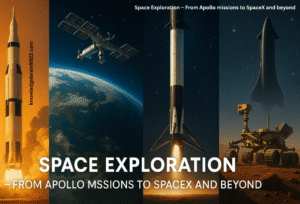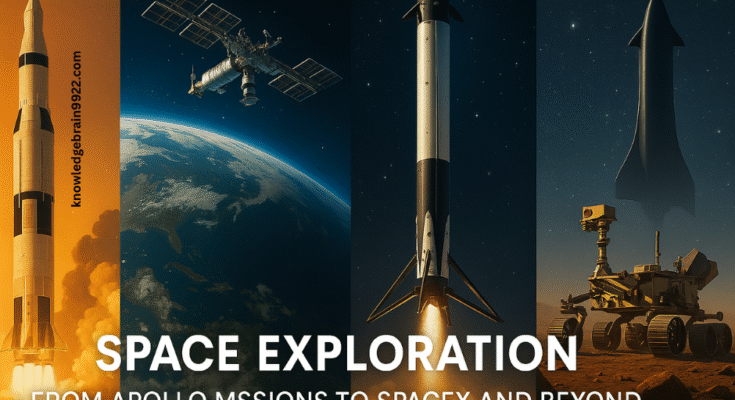
Space Exploration Space Exploration: From SpaceX up to Apollo Missions and Beyond Overview Exploring beyond our planet has driven technological advancement and the nation’s pride and insatiable ambition from the moment we began looking at the sky. The launch of the first rockets are now private initiatives which aim to Mars or other international space stations, as also interplanetary space probes. This article will focus on key turning points that have a significant impact on technological advances as well as the upcoming space frontier as it explores the progress of space exploration from space exploration from the Apollo moon mission and continuing to today’s spacecrafts that are reusable and commercial and space flight.
Theoretical Underpinnings for Early Visionaries and Rocket Pioneers
The concept of space travel was first developed in the late portion of the 19th and beginning of the 20th century through pioneers like Hermann Oberth, Robert Goddard along with Konstantin Tsiolkovsky. The rocket equation developed by Tsiolkovsky explained the method by the liquid-fueled rockets could reach orbital speed. A first spacecraft that was powered with liquids was developed by Goddard the year 1926. It proved to be a reliable propulsion system. The entire generation of engineers and romantics were inspired by the work of Oberth. The collective wisdom of their generation made the space race an idea of sci-fi into reality.
The Second World War and the V-2 Rocket
Ballistic missiles first became widely utilized in World War II when Nazi Germany developed V-2, the first rocket. V-2. V-2 was a rocket that V-2 demonstrated the capability of propellants made from liquid and also gyroscopic-guided in addition to hypersonic flight. All in the context of weapon. The US and the USSR were able to capture V-2 people and their technology following the conflict. It has also accelerated the space and missile programs.
The Mercury-Gemini Programs and the Space Race
Gagarin, Yuri, and Sputnik
Space Race began. Space Race began when the Soviet Union launched Sputnik 1 in October of 1957 delighting everyone across the globe. Yuri Gagarin became the first human to orbit Earth by using Vostok 1 during April being the first to orbit Earth in the process of securing the top spot for that Soviet Union in the initial human-manned spacecraft.
Mercury Project
In retaliation to the US as a retaliation move, the US initiated Project Mercury (1958-1963) to launch the first US individual into Space. John Glenn’s spaceflight in the spacecraft orbit Friendship 7 in February 1962 was in the wake of Alan Shepard’s suborbital flight on Spacecraft Freedom 7. Mercury set the stage for greater and more interesting initiatives that demonstrated vitality via capsule re-entry as well as the achievement of humans surviving the space launch and returning.
Gemini Project
Between the year 1962 and the period of 1966, Project Gemini was an essential interaction between Mercury and Apollo. Essential abilities to construct multi-module spacecrafts headed towards the Moon were tested during the Gemini missions. These included docking, orbital rendezvous and docking extended-duration flights as well as Spacewalk (EVA). The Gemini mission was able to extend human endurance by 2 weeks in space spacecrafts Gus Grissom, Ed White as well as the Gemini missions demonstrated that spacecraft could make it all the way to moon.
The HTML0 was First Lunar Landings with Apollo
The Apollo 1 Disaster and the Resilience of the Program
In the event that astronauts Gus Grissom, Ed White and Roger Chaffee perished in a incident that occurred in a cabin during an on-ground test in the month of January, 1967, an overhaul was required. NASA improved security procedures and safety protocols after experiencing disasters, and also proving its commitment to the President’s dream would be “landing a man on the Moon and returning him safely to Earth” before the end of the decade.
Apollo 11: One Massive Step
The strongest rocket ever constructed, Saturn V, launched Apollo 11 on July 16 1969. Buzz Aldrin’s exploratory work as well as Neil Armstrong’s “one small step” became historic events when they reached the moon four days following. All three had been completed with Michael Collins, who stayed on the moon’s surface while on Columbia. Apollo’s accomplishments provided lunar treasures as well as boosted national pride as well as demonstrating American scientists their leadership in science.
The Legacy of Apollo
Six of the successful Moon moon landings (Apollo 11-17 apart from Apollo 13 that devastatingly lost Apollo 13) from 1969 and 1972 brought back more than 380 kilograms of lunar rock to be studied. The lunar geology information and Earth-Moon dynamics were obtained through the instruments used by scientists upon the lunar surfaces such as retroreflectors and seismometers. Apollo brought improvements in human-related issues along with advances in materials science as well as the guiding system which remains relevant to current space missions.
Long-Duration Habitation and Space Stations
Skylab and Salyut
Soviet Union turned its attention toward Earth orbit after Apollo in 1971. This was followed by the launch of the satellite Salyut 1, in 1971. Microgravity experiments were performed by scientists and performed by crews of spacecrafts. To counter the effects of this in 1971, scientists in their home country of the United States established Skylab (1973-1974) where they conducted the solar and biophysical physics projects. After sustaining damages during its launch Skylab team members were able to get an extensive repair and performed over 250 experiments.
The Original Modular Station, Mir
Modular construction and as in addition to long-term housing were developed by the USSR’s Mir Space Station (1986-2001). for the period of a year the crew lived onboard to research the psychological impact of living in a restricted space space, radiation exposure along with bone loss. Through hosting space travelers from all over the world, Mir set the stage for collaboration in the future.
The International Space Station (ISS)
A partnership together with NASA, Roscosmos, ESA, JAXA, and CSA and CSA and CSA, the ISS was launched in the year 1998. Since then it has been in operation for the ISS is the most powerful craft designed by humans that is continuously utilized. Humanity has prepared for missions to the moon, as and Mars through microgravity-based studies in biology, physics, and materials science, as well as demonstrations of science (3D printing and robotics).
Robotic Solar System Exploration
Early Orbiters and Flybys
The information we’ve learned has improved significantly over the operations with crews, thanks to robotic instruments. Between 1962 between 1962 and 1973, NASA’s Mariner missions travelled to Venus, Mars, and Mercury. The first successful surface explorations on Mars were carried out with Viking Landers in 1976 which investigated the planet to look for evidence of living creatures.
Voyager and Voyager as well as Voyager Outer Planets The longest-running of our space probes Voyager 1 and 2 began operations in 1977. Since then, they’ve studied Jupiter, Saturn, Uranus in addition to Neptune. The probes are currently travelling through the interstellar the space. They’re Golden Records as well as the famous “Pale Blue Dot” image emphasise the significance of human beings in the Universe.
Present-Day Missions and Mars Rovers
Sojourner Spirit, Opportunity, Curiosity and Perseverance are Mars Rovers that have travelled through the Martian surface, studying the soil, finding the old riverbeds and gathering data to be used in future applications. Exploration by aircraft was demonstrated during April 2021, when the Ingenuity helicopter took its first flight powered towards the other planet.
Beyond the Lunar
The moon’s outer sides were dropped from orbit followed via the Chinese Chang’e lunar mission. NASA’s New Horizons (2006) has provided the first high-resolution photographs of Pluto along with some of Kuiper Belt objects Arrokoth and the ESA’s BepiColombo (2018) will soon be heading toward Mercury.
The Development of Commercial Spaceflight: Initial Private Initiatives
Small-scale businesses began providing launch services to satellites as early as the late 1990s and early 1980s. Suborbital models are the outcome of the introduction of concepts to space tourism.
Reusability and SpaceX
Elon Musk was the founder of SpaceX in 2002. The first Falcon 1 successful launch into orbit 2008 revolutionized the world of space flight. Costs for launch were reduced to a minimum through the initial stage landings, which could be reused and had been tested since 2015. First space craft which was privately owned and operated to join with the International Space Station (ISS) was SpaceX’s Dragon capsule. It was began its launch in the year 2012. Following that the spacecraft was also able to take passengers on Space Agency’s Commercial Crew Program (Crew Dragon Demo 2 in 2020).
Virgin Galactic, Blue Origin, and Others
Richard Branson’s Virgin Galactic and Jeff Bezos’s Blue Origin both emphasise suborbital space travel and the reuse in rockets. In the Blue Origin case Blue Origin, the New Shepard of Blue Origin has completed a series of tests with teams. Firms like Relativity Space and Rocket Lab build small satellite launchers that are aimed at the commercial space that is growing.
Returning to the Moon: Artemis and Beyond Artemis Initiative
NASA has revealed the launch of its Artemis program in 2019, which will attempt to revive lunar exploration, and be the first human and female on the moon prior to the mid-point in 2020. As the Gateway Habitat is utilized as staging, and for crews travel via the Orion spacecraft, as well as spacecraft and the Space Launch System (SLS) rocket. Landers from commercial organizations will supply research packages and tests that enable the continuous existence of the lunar space. They were created by firms like Intuitive Machines and Astrobotic.
Global Lunar Gateway
International Partners ESA, JAXA International Partners ESA, JAXA, and CSA provide modules and logistical support for and support the Lunar Gateway in the context of the Artemis Accords. The efficacy of ISS is apparent through the collaboration strategy that shares knowledge and resources across the three organizations.
Mars and the Upcoming Frontier
Human Expeditions to Mars
Mars is among the most satisfying reward of exploration in space. The 2030s will witness companies such as SpaceX, NASA, and ESA are planning to launch missions with astronauts. Protection from radiation and life support propulsion and mental well-being during longer-term trips are only the most pressing issues. One of the main goals of concepts like closed loop habitats and nuclear thermal power is to break the boundaries.
Ambitions for Private Mars
Transporting crews and cargo with the intention of transporting them to space, Moon, Mars, and beyond is the aim of SpaceX’s Starship that is made of all recyclable components. launch vehicle as well as land craft. Though extensive tests and certifications for safety are underway, Starship may democratise interplanetary transport with its speedy recycle and large payload.
Innovations in Deep Space Exploration Propulsion and Future Technologies
Electronic Propulsion: Thermojets can provide high-quality, low-thrust deep space orbit corrections that are suitable for missions including NASA’s Dawn and BepiColombo, a mission of ESA.
Nuclear Propulsion in cutting the duration required to get to Mars by half, ideas like Nuclear Thermal Missiles (NTR) could decrease the danger of exposure in cosmic radiation.
Utilisation of In-Situ Resources (ISRU)
By making oxygen from the lunar regolith Martian CO2 prior to turning into propellants, futurists are hoping to extract locally-sourced energy sources. Through reducing the burden of payloads that are that are imposed on Earth ISRU will make possible for settlements off the planet to be economically viable.
Tourism and Space Habitats
Space stations commercially operated as Orbital Reef and Axiom Station have been designed to house factories, people and study. The large living areas and reduced weight can be achieved because of the advances with inflatable structures, for example Bigelow Aerospace. In 2020, there is a possibility of hotels in space will be operational.
Policy, Legal, and Ethical Aspects
Treaty on Outer Space
Space is in the of all people as per the treaty signed in 1967 commonly referred to the Outer Space Treaty, which restricts national appropriation as much as the use for weapons of mass destruction inside Space. The clarification of the use of resources and the properties rights (such mining an asteroid) is essential as there is a greater number of participants in the space area.
Protection of the Planet
The strict sterilization of spacecraft and sample samples is essential to prevent contamination from biological organisms on Earth as well as other planets in order to find the ideal balance between pursuing and conserving the possibility of life elsewhere on planets.
Fair Access
policies that include all must be implemented to assure that space is beneficial to everyone and every country. Participation in international space exploration could be encouraged by creating partnerships with nations that are in need, as well as building capacity programs, and equitable information sharing.
To conclude
Space exploration has improved our knowledge of science and technology capabilities, as well as international collaboration, as evidenced by the successful completion in space exploration, the Apollo moon landings and SpaceX’s groundbreaking breakthroughs. With the ambitious objectives set in place for Mars, Artemis ready to take humans back to the Moon along with profitable commercial enterprises, the next decade is sure to alter our relations with the outside planet. The question is whether space will remain an accessible field for everyone will depend on how we address the environmental, ethical and legal issues as our eyes are set on the sky. The eternal truth can be evident through our journeys through Earth toward Mars, the Moon, Mars, and beyond. Exploring expands the possibilities of exploration as well as increases our knowledge of the world around us.



